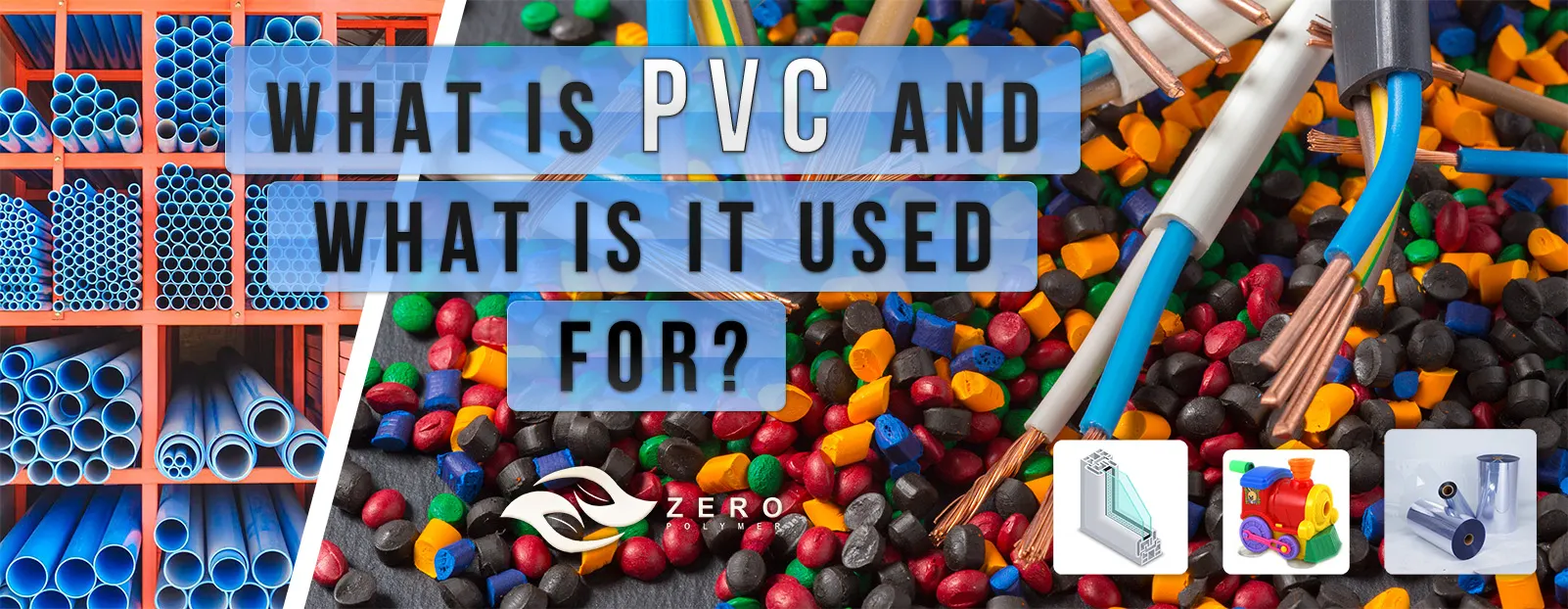
What Is PVC?
Polyvinyl chloride (PVC) is one of the most widely used plastics in the world. It is well-known for its extensive range of applications across various industries.
PVC is a synthetic polymer made from vinyl chloride monomers and is popular for its versatility and durability. From construction and automotive to healthcare and packaging, PVC is found in countless products we use every day.
PVC products are known for their durability and longevity. For instance, PVC flooring and roofing can last for more than 20 years, while PVC water pipes used in infrastructure projects can last for more than 50 years. Additionally, PVC products can be recycled and reused. The recycling process involves grinding PVC into small pieces. These pieces are then processed into compounds that can be melted and formed into new products.
This polymer can come in white, black, and a wide range of colors in between. PVC can be rigid or flexible, depending on the additives and processing techniques used during its production. In its rigid form, PVC is often used for pipes, fittings, and construction materials. In its flexible form, it is used for items such as inflatable structures, hoses, cable insulation, and vinyl flooring.
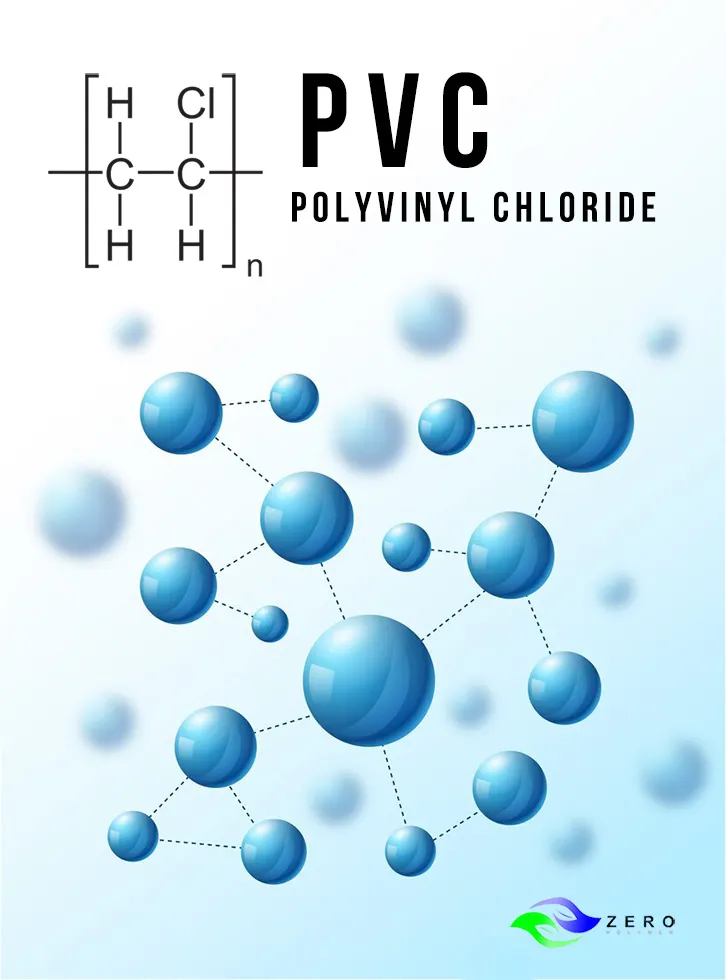
This polymer can come in white, black, and a wide range of colors in between. PVC can be rigid or flexible, depending on the additives and processing techniques used during its production. In its rigid form, PVC is often used for pipes, fittings, and construction materials. In its flexible form, it is used for items such as inflatable structures, hoses, cable insulation, and vinyl flooring.
History of PVC
Did you know that PVC, one of the most widely used polymers today, was invented over a century ago? In fact, the German inventor Friedrich Klatte was awarded the very first patent for a polymerization process used to manufacture PVC way back in 1913. Thanks to his groundbreaking work, we can now enjoy the benefits of this versatile and durable material in a wide range of applications.
By the time World War I began, Germany had already started manufacturing several flexible and rigid PVC products. They were using them as a substitute for corrosion-resistant metals.
PVC has been commercially produced since 1933 and currently makes up around 20% of all plastic manufactured worldwide, placing it second only to polyethylene in terms of production volume.
PVC Production Process
The production process of Polyvinyl Chloride (PVC) involves several important steps. First, chlorine is extracted from salt via electrolysis. Then, Ethylene undergoes a chlorination reaction which results in vinyl chloride monomer (VCM). Next, VCM is polymerized to create PVC resin. Additives are introduced to enhance the PVC's properties. Finally, the PVC is shaped into desired products through processes like extrusion, injection molding, or calendaring.
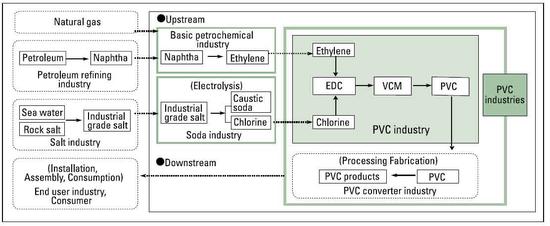
Raw Materials and Sustainability
Polyvinyl chloride (PVC) is a synthetic material derived from natural resources, specifically oil and salt. The production of PVC involves the use of ethylene and chlorine as raw materials.
Ethylene is obtained from petroleum or natural gas, while chlorine is derived from common salt through a process called electrolysis.
Approximately 57% of PVC is made out of chlorine, which is abundant on earth, and helps save oil, a non-renewable resource. This makes PVC well-suited to recycling. As an examples, 50% of end-of-life agricultural films being recycled in Japan and over 150,000 tons of post-consumer products being recycled in Europe in 2007.
Compared to other materials, the PVC industry has a better understanding of its environmental impact and has consistently found that it is not much different from other materials. It even has some positive environmental effects, such as fewer CO2 emissions from production processes.
Bi-Products: Chlorine and Caustic Soda
Chlorine and caustic soda are key by-products of the PVC production process. In the manufacture of vinyl chloride monomer (VCM) and PVC, manufacturers utilize chlorine. That accounts for approximately 57% of PVC by weight. It is also a key component in water treatment and is used in various everyday products.
Caustic soda, or sodium hydroxide, is a chlorine manufacturing co-product. It has various applications in aluminum, consumer goods, construction materials, and pharmaceuticals.
The chlor-alkali industry produces chlorine and caustic soda, which are key components in PVC production. Additionally, around 35-40% of the chlorine produced is used for making PVC.
Demand for chlorine is influenced by PVC demand, driven by construction and infrastructure investment. Chlorine and caustic soda play essential roles in manufacturing diverse modern materials. Both products are necessary and have wide-ranging applications.
PVC Types: Flexible and Rigid
Polyvinyl chloride (PVC) is a popular material that comes in two primary types: flexible and rigid. Flexible PVC (FPVC), is known for its pliability and ability to bend. That makes it suitable for applications such as tubing, hoses, and electrical insulation. It can conform to different shapes and is often used in situations that require flexibility.
On the other hand, rigid PVC, also known as UPVC or PVC-U (The U stands for "unplasticised") is popular for its strength and durability. Manufacturers commonly use it in construction, plumbing, and other structural applications where rigidity is essential. Rigid PVC pipes, for example, are commonly used in water distribution and drainage systems due to their excellent resistance to corrosion and chemical substances.
Understanding the differences between flexible and rigid PVC types is important. Therefore, it helps in selecting the appropriate material for specific applications.
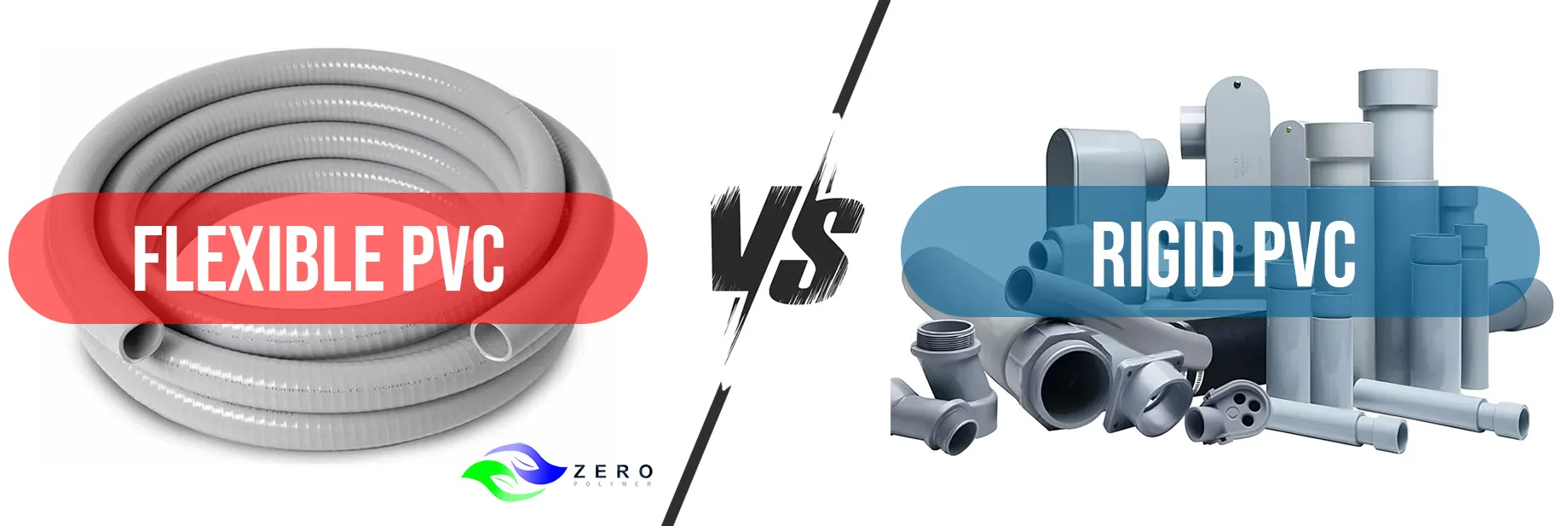
Understanding PVC-O, PVC-M, and CPVC
In addition to traditional flexible and rigid PVC, there are also specialized forms such as PVC-O, PVC-M, and CPVC.
PVC-O, or oriented PVC, is produced through a molecular orientation process, resulting in improved mechanical properties and higher pressure ratings compared to standard PVC. It is commonly used for pressurized water pipes, providing enhanced resistance to impacts and cracks.
PVC-M, or modified PVC, is created by adding specific additives to the PVC formulation. This modification enhances the material's impact strength and resistance to high temperatures. PVC-M is often used in scenarios where pipes may be subjected to varying temperatures or require high impact resistance.
Lastly, chlorinated polyvinyl chloride (CPVC) is a thermoplastic material known for its high resistance to heat and chemical corrosion. Manufacturers commonly use it for hot water supply systems. Each of these specialized PVC types offers unique properties and advantages, allowing for a more tailored choice based on specific project requirements.
Weighing Pros and Cons of Rigid vs. Flexible PVC
When considering the use of PVC, it is crucial to weigh the pros and cons of both rigid and flexible variants to determine the most suitable option for a particular application.
Rigid PVC is valued for its strength and durability, making it ideal for applications that require structural support or exposure to heavy loads. It maintains its shape and rigidity over time, ensuring long-term performance. However, rigid PVC lacks flexibility and may not be suitable for projects that require bending or conforming to tight spaces.
On the other hand, flexible PVC offers excellent flexibility and versatility, allowing it to adapt to various shapes and contours. It is highly resistant to impact damage and can withstand bending without cracking or breaking. However, flexibility comes at the expense of reduced strength and dimensional stability compared to rigid PVC.
Careful evaluation of project requirements is essential to select the appropriate PVC type. Factors such as design constraints, functional needs, and budget considerations should be taken into account when deciding between rigid and flexible PVC.
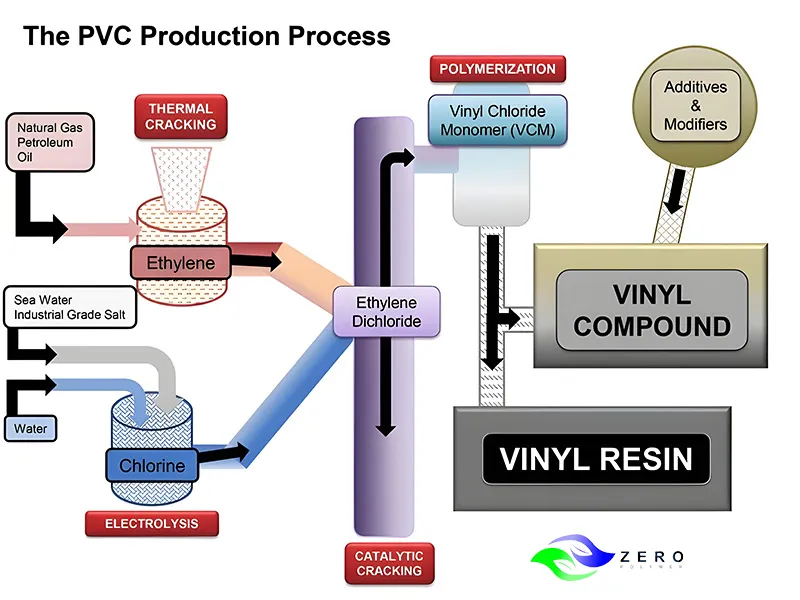
How PVC is Made and Its Physical Properties
Polyvinyl chloride (PVC) is a widely used plastic material with diverse applications in construction, healthcare, automotive, and various other industries. Understanding how PVC is made and its physical properties is crucial for manufacturers, engineers, and end-users.
PVC is synthesized from the monomer vinyl chloride through a process called polymerization.
There are three main methods for producing PVC: suspension polymerization, emulsion polymerization, and bulk polymerization.
Each method has its own advantages and is chosen depending on the desired properties of the PVC.
Suspension vs. Bulk/Emulsion: Behind PVC Manufacturing
The manufacturing of polyvinyl chloride (PVC) involves various production methods, each with its own distinct advantages and applications. The choice between suspension polymerization, bulk polymerization, and emulsion polymerization significantly impacts the physical and chemical properties of the resulting PVC.
Suspension polymerization
Suspension polymerization is the most commonly used method. It involves suspending vinyl chloride monomer in water and polymerizing it in the presence of initiators and suspending agents. This method yields PVC with excellent mechanical properties, making it suitable for rigid applications such as pipes, fittings, and profiles. The particles obtained from suspension polymerization are on the larger side, leading to good impact resistance and weatherability.
Bulk polymerization
Bulk polymerization, on the other hand, directly polymerizes the vinyl chloride monomer without the use of water. This method produces PVC with a high molecular weight, imparting enhanced mechanical and thermal stability. Bulk polymerized PVC is ideal for applications that require increased rigidity and strength, such as in the construction and automotive industries.
Emulsion polymerization
Emulsion polymerization involves the polymerization of vinyl chloride monomer in an aqueous emulsion, resulting in PVC with finer particles. This method offers energy efficiency and yields PVC with good flexibility and elasticity, making it suitable for applications such as films, coatings, and medical devices. Emulsion polymerized PVC is often used in products that require a balance between rigidity and flexibility.
The choice of manufacturing method for PVC is influenced by the desired properties of the end product. Factors such as molecular weight, particle size, and distribution play a crucial role in determining the mechanical, thermal, and processing properties of the PVC. Understanding the distinctions between suspension, bulk, and emulsion polymerization is essential for manufacturers to tailor PVC formulations to meet specific application requirements.
PVC's Electrical, Durability, and Flame-Retardant Properties
Polyvinyl Chloride (PVC) is a widely used thermoplastic polymer with various applications in construction materials, electronics, and other industries. Some of the key properties of PVC that make it a popular choice include its electrical, durability, and flame-retardant properties.
Electrical Properties
PVC is an excellent electrical insulator, making it ideal for use in electrical wiring and cable applications. It is resistant to moisture, chemicals, and abrasion, which contributes to its durability and versatility in various electrical applications.
Durability Properties
PVC is known for its high durability, which is why it is used in a wide range of applications. It is resistant to moisture, chemicals, and abrasion, making it suitable for both indoor and outdoor use.
Flame Retardant Properties
PVC is inherently fire resistant due to its chlorine content, which accounts for more than 50% of its composition. When PVC products are burned, hydrogen chloride gas is released, which slows down the continuous combustion reaction and makes it easier to detect a fire. This feature allows early detection of a fire and reduces the risk of damage to electrical wiring and other materials.
Fire retardant
Fire retardant PVC is made by adding flame retardant chemicals to the material, which act as a barrier to prevent or delay the spread of flames in case of fire. This PVC retains the durability and versatility of regular PVC, making it suitable for a wide range of applications, including electrical wiring, construction materials, transportation, cables, pipes, roofing materials, and interior furnishings.
Applications of Fire Retardant PVC
Fire retardant PVC is used in various applications where fire safety is a critical concern. Some of these applications include:
Electrical wiring protection: Fire retardant PVC conduit pipes are used to protect electrical wiring in buildings with high occupancy or flammable materials.
Construction materials: Fire retardant PVC is used in the production of windows, doors, water and sewage pipes, and lighting ceilings.
Transportation: Fire retardant PVC is used in the production of automotive components, such as fuel pipes, water and sewage pipes, and electric cables.
Enhancing PVC: Additives and Blends
PVC, or Polyvinyl Chloride, is one of the most versatile and commonly used polymers in the world. It is durable, easy to process, and highly cost-effective. However, while PVC is a great material, it has some limitations that can be addressed by using additives and blends. This article explores how adding certain materials to PVC can enhance its properties and widen its range of applications.
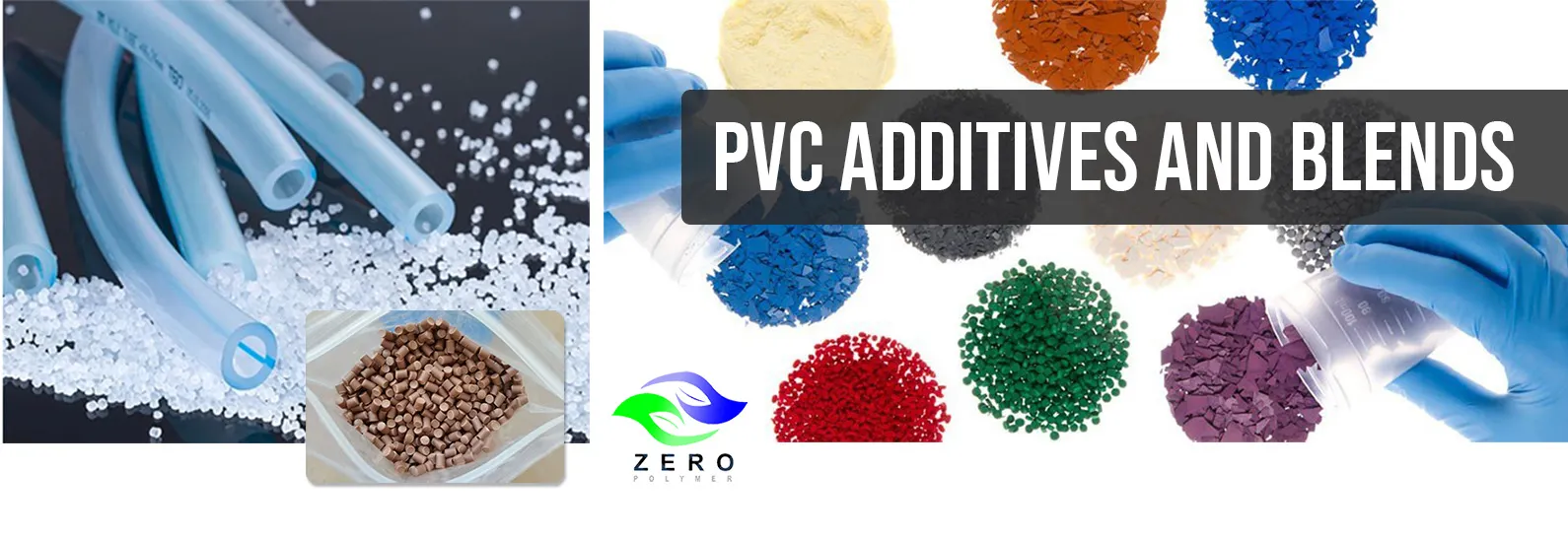
What are additives and blends?
Additives and blends are materials that are added to PVC to modify its properties. Additives are substances that are added in small amounts to PVC to make it more versatile, durable, and functional. Blends, on the other hand, are a combination of two or more polymers, or a polymer and a plasticizer, which are mixed to achieve specific performance characteristics.
Types of Additives
There are numerous types of additives that can be used with PVC. These include:
Stabilizers
Stabilizers are the most common type of additive used with PVC. They protect PVC from heat, UV rays, and oxidation. Without stabilizers, PVC can become brittle and discolored over time. There are several types of stabilizers used with PVC, including:
Heat stabilizers - used to prevent PVC from degrading due to heat exposure
UV stabilizers - used to protect PVC from the effects of UV rays from the sun
Oxidation stabilizers - used to prevent PVC from breaking down due to oxidation.
Plasticizers
Plasticizers are additives used with PVC to make it more flexible and easier to process. They work by breaking down the rigid structure of PVC, making it more pliable. Plasticizers are especially useful when working with PVC in cold weather conditions where PVC can become less flexible. While plasticizers are an effective additive, overuse can lead to the release of volatile organic compounds (VOCs), which can be harmful to human health and the environment.
Impact Modifiers
Impact modifiers are additives used with PVC to increase its impact resistance. They work by reducing the brittleness of PVC and allowing it to absorb more energy from impacts. Impact modifiers are especially beneficial in applications where PVC is exposed to dynamic stresses, like in packaging, building products, and automotive parts.
Types of Blends
Blends are a mix of two or more polymers or a combination of a polymer and a plasticizer. Blending PVC with other polymers or additives can help to improve its properties. Some of the most common PVC blends include:
PVC/ABS Blends
PVC/ABS blends are a combination of PVC and Acrylonitrile Butadiene Styrene (ABS). They offer a balance of mechanical properties, heat resistance, and impact resistance, making them ideal for automotive and construction applications.
PVC/Nitrile Rubber Blends
PVC/Nitrile rubber blends are a combination of PVC and nitrile rubber. They offer excellent oil resistance, making them ideal for seals and gaskets used in the automotive and oil industries.
PVC/TPU Blends
PVC/TPU blends are a combination of PVC and thermoplastic polyurethane (TPU). They offer excellent abrasion resistance and flexibility, making them ideal for applications in the sports and leisure industry.
Roles of Plasticizers, Stabilizers, and Lubricants in PVC Polymer Processing
Plasticizers, stabilizers, and lubricants are vital additives in the field of polymer processing. These additives play crucial roles in enhancing the properties and performance of polymers, making them more versatile and durable. Understanding the functions and benefits of plasticizers, stabilizers, and lubricants is essential for achieving successful polymer processing.
The Role of Plasticizers
Plasticizers are additives used to increase the flexibility and workability of polymers. By lowering the glass transition temperature (Tg) of the polymer, plasticizers help transform rigid and brittle materials into flexible ones. This is accomplished by reducing the intermolecular forces between the polymer chains, which allows for increased chain mobility. Plasticizers improve the ease of blending, extrusion, and molding during polymer processing.
Apart from enhancing workability, plasticizers also contribute to the durability and longevity of polymer products. They improve impact resistance, reduce the chances of material failure, and enhance the overall mechanical properties of the polymer. Plasticizers can also improve the resistance of polymers to environmental factors such as heat, UV radiation, and chemicals. This attribute can be beneficial in applications where polymers are exposed to challenging conditions. Additionally, plasticizers can lower production costs by enabling the use of lower-cost polymers through modifying their properties.
The Role of Stabilizers
Stabilizers are additives that help prevent premature degradation of polymers during processing and throughout their service life. Polymers are vulnerable to degradation caused by heat, light, oxygen, and other environmental factors. This degradation can lead to a loss of mechanical properties, discoloration, and reduced product lifespan.
Stabilizers act as protective agents, minimizing the effects of degradation and maintaining the integrity of the polymer. They scavenge free radicals, inhibit chain scission, and reduce the impact of UV radiation. Stabilizers can significantly extend the lifespan of polymer products.
There are various types of stabilizers, including heat stabilizers, UV stabilizers, and antioxidant stabilizers. Heat stabilizers guard polymers against thermal degradation during processing, while UV stabilizers shield polymers from the harmful effects of ultraviolet radiation. Antioxidant stabilizers inhibit oxidation reactions, preventing the premature aging of polymers.
The Role of Lubricants
Lubricants are additives primarily used to reduce friction and improve the flow properties of polymers during processing. They enhance the melt flow by reducing melt viscosity and preventing polymer sticking to processing equipment. Lubricants also aid in the dispersion of other additives, improving the homogeneity of the polymer blend.
Beyond processing benefits, lubricants can enhance the surface finish and appearance of the final product, reducing surface defects such as flow marks and imperfections. They help achieve a smoother and more aesthetically pleasing outcome.
Moreover, lubricants facilitate the release of the polymer from molds or processing equipment, reducing the risk of material sticking and enabling easier demolding.
PVC's Compatibility with Polyester, PU, NBR, and Polyolefin Rubber Alloys
When it comes to compatibility with other materials such as polyester, polyurethane (PU), nitrile (NBR), and polyolefin rubber alloys, it is essential to consider the potential interactions and effects on the performance of the final product.
Compatibility Considerations
Polyester: PVC is generally compatible with polyester. This combination offers good resistance to various chemicals, including acids, alkalis, and oils. However, it is crucial to consider the specific formulation and processing conditions to ensure optimal compatibility.
Polyurethane (PU): PVC and PU can be compatible, particularly in certain applications where flexibility and durability are required. However, it is essential to note that the compatibility can vary depending on the specific types and formulations of PVC and PU used. Conducting compatibility tests is recommended to ensure the desired performance.
Nitrile (NBR): PVC and NBR are generally compatible. The combination offers good resistance to oils, fuels, and other petroleum-based substances. However, it is important to consider the specific requirements of the application and perform compatibility tests to ensure long-term performance.
Polyolefin rubber alloys: Polyolefin rubber alloys, which are blends of different polyolefin materials, can have varying levels of compatibility with PVC. Compatibility studies are necessary to evaluate the compatibility and optimize the performance of the final product.
Conducting Compatibility Tests
To determine the compatibility between PVC and the mentioned materials, it is recommended to conduct thorough compatibility tests. These tests involve exposing the materials to the desired chemicals, temperatures, and environmental conditions that mimic the intended application. The tests can help identify any potential issues, such as changes in physical properties, chemical reactions, or diminished performance.
It is also worth noting that compatibility can be influenced by factors such as processing conditions, additives, and environmental exposure. Considering these aspects and consulting experts in the field can provide valuable insights and ensure successful material compatibility.
Diverse Applications of PVC Across Industries
PVC is a versatile material that finds diverse applications across various industries. Its unique properties make it a preferred choice in construction, healthcare, electronics, automotive, and sport, among others. Let's explore some of the key applications of PVC in different sectors.

PVC in Construction:
From Window Frames to Roofing
PVC is a vital material in the construction industry, with numerous applications. Some of them are window frames, door frames, roofing, and cladding. Its versatility and durability make it an ideal choice for both interior and exterior construction projects.
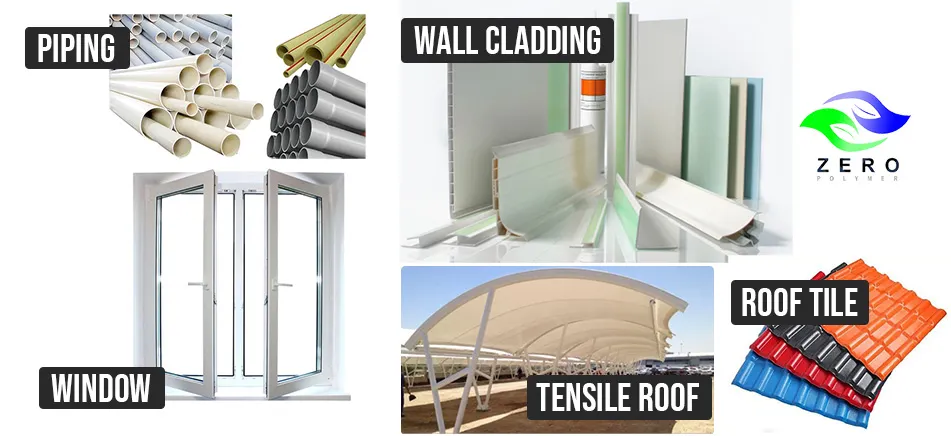
Windows frame applications
In construction, companies prefer PVC in window frames. Because it has an excellent insulation property, resistance to weathering, and low maintenance requirements. PVC frames offer energy efficiency by preventing heat loss or gain, enhancing the overall energy performance of buildings. Additionally, PVC window frames have high sound insulation capabilities. That promotes a quiet and comfortable indoor environment.
Roofing applications
PVC is also a favorable material in roofing applications. It provides excellent resistance to UV radiation, weathering, and chemical degradation. PVC roofing membranes offer superior durability, flexibility, and waterproofing properties, making them suitable for various roofing systems. Companies utilize PVC roofing in commercial, industrial, and residential buildings. Since it offers long-term protection against water infiltration and environmental factors.
Door frame and cladding applications
Furthermore, many companies utilize PVC in door frames, cladding, wall panel and other construction applications. Owing to its lightweight nature, easy installation, and resistance to moisture, termites, and rot. These attributes contribute to the longevity and sustainability of PVC building components.
Piping systems and construction
PVC, or polyvinyl chloride, is widely used in piping and construction due to its various beneficial properties. In piping, constructors utilize PVC for transporting drinking water, drainage solutions, and advanced fire-sprinkler systems. Its smooth surface reduces pumping costs and energy use. While leak-free fittings eliminate water loss, making it an environmentally friendly and cost-effective choice for piping systems.
PVC is also employed in sewer and wastewater conveyance, as well as in drains, vents, and waste handling and control within structures and equipment.
Its resistance to weathering, corrosion, and decay makes it an excellent choice for exterior applications, such as fascia boards and soffit boards.
PVC in Healthcare:
From Life-Saving Devices to Innovations
Polyvinyl Chloride (PVC) is a versatile and cost-effective material that finds extensive usage in the healthcare industry. Owing to its durability, chemical resistance, and biocompatibility. The medical field widely employs PVC in various medical devices. That has played a pivotal role in transforming healthcare delivery over recent decades.
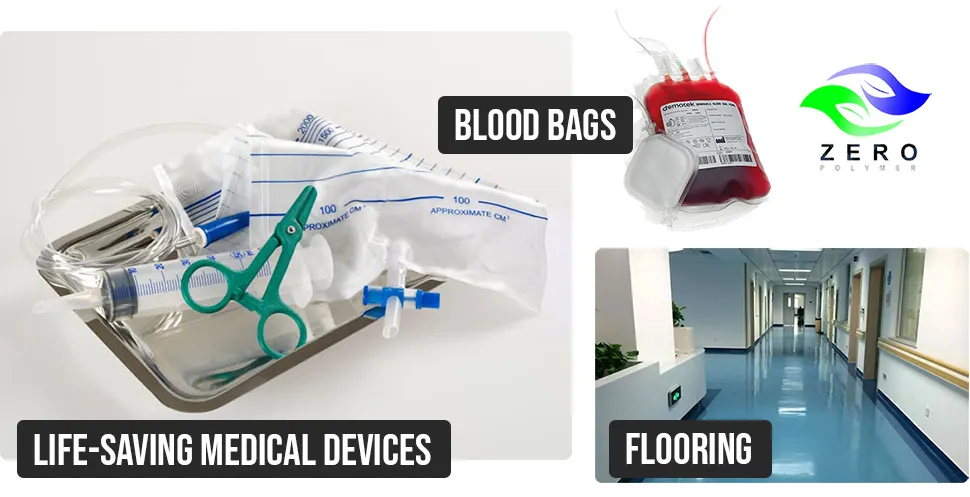
PVC in Life-Saving Medical Devices
PVC is the material of choice for a range of life-saving medical devices, especially blood bags, due to its high biocompatibility and hemocompatibility. It is used to make tubing, oxygen masks, containers for IV and dialysis fluids, IV sets, nasal cannulas, overshoes, examination and surgical gloves, blood vessels for artificial kidneys, blister packaging, mattress covers, and training manikins.
PVC has excellent chemical stability and is compatible with virtually all pharmaceutical products in healthcare facilities today. It also has excellent water and chemical resistance, helping to keep solutions sterile. PVC medical devices can be easily sterilized via steam, autoclave, radiation (electron beam or gamma rays), or ethylene oxide methods, maintaining their key properties such as resistance to scratches and kinks.
Innovations in PVC for Healthcare
Innovations in PVC are helping to improve patient experience and safety in hospitals. Antimicrobial additives can now be bound into the PVC, which, along with excellent cleaning and disinfection practices, can reduce the prevalence of Hospital-Acquired Infections (HAIs). Aesthetic innovations in PVC are also improving the patient experience in hospitals, with the ability to include almost any color, pattern, or shape in a PVC design.
PVC has long been known as a hard-wearing product, which is easy to clean. Its resistance to knocks and scratches makes it ideal for wall coverings in high traffic areas like hospitals. PVC flooring has the added advantage of being shock absorbent, making it comfortable to walk on, and its anti-static properties protect people and sensitive electronic equipment from static.
PVC and Sustainability in Healthcare
Polyvinyl chloride (PVC) is not only versatile and cost-effective but also contributes to sustainability in healthcare. PVC can be recycled 8 to 10 times without loss of functional properties, and several countries have established PVC recycling programs in partnership with medical care facilities. The VinylPlus® Med partnership, for example, gathers hospitals, waste managers, recyclers, and the PVC industry to accelerate sustainability in healthcare.
The global medical PVC plastic market is projected to experience significant growth in the coming years, driven by increasing demand for PVC in medical applications, growing healthcare infrastructure, rising geriatric population, and technological advancements in medical devices.
PVC in Electronics, Automotive, and Sport: A Versatile Player
Polyvinyl Chloride (PVC) is a versatile and cost-effective material that has found extensive applications in various industries, including electronics, automotive, and sports. Because it has unique properties such as durability, chemical resistance, and electrical insulation.
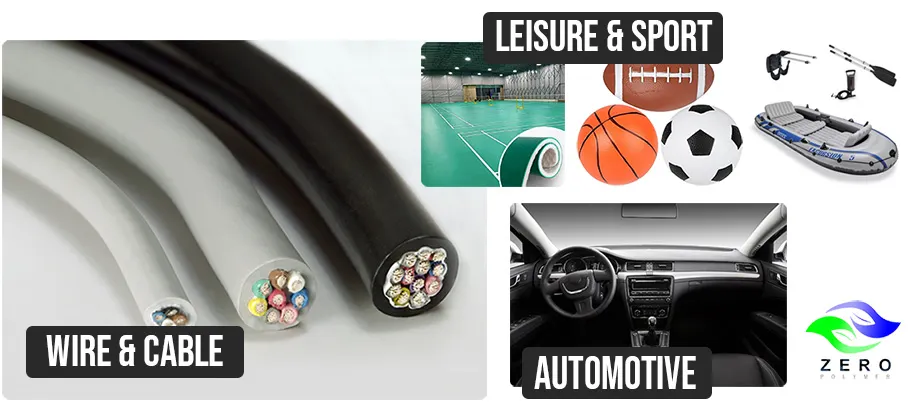
PVC in Electronics
In the electronics industry, manufacturers can massively utilize PVC in cable insulation due to its toughness, resistance to abrasion, and decent mechanical strength. It provides excellent electrical insulation properties, which is crucial in preventing electrical shorts between the Printed Circuit Board (PCB) and the surrounding components or chassis. PVC wires and cables are extremely durable and versatile, resistant to UV, acids, alkalis, oils, and many corrosive substances. This makes them ideal for various applications, including those that require exposure to harsh environmental conditions.
PVC in Automotive
PVC plays a significant role in the automotive industry, contributing to vehicle performance, efficiency, and safety. Producers use it in underbody coatings, sealants, wire harnesses, synthetic leather for seats, passenger compartment parts, and small exterior trims. PVC's use in vehicles contributes to reducing the weight and increasing the fuel efficiency of modern cars.
PVC is also important in shock-absorbing vehicle components such as 'soft' dashboards, reducing injury in the case of impact. Producers use fabrics coated with PVC in life-saving vehicle airbags, while the fire-retardant properties of the material contribute to the overall safety of a vehicle.
The use of PVC in the automotive industry is not only cost-effective but also environmentally sound. It helps to make vehicles more affordable, and its lightweight nature helps to reduce the overall weight of any vehicle, which in turn, lowers wear and tear on the roads, and can decrease fuel consumption.
PVC in Sports
In the world of sports, PVC's durability, longevity, and ability to withstand considerable physical stress make it a popular choice for various applications. It finds uses in the construction of sporting venues, including flooring, roofing, piping, and seating.
PVC is also a favorable material in sports equipment and protective gear. Companies use PVC in the production of tennis nets, floors of gyms and playgrounds, balls, bags, mats, boxing gloves, clothing, footwear, and more. It is also important in the construction of stadiums and sports centers, providing a combination of architectural freedom with environmental responsibility.
PVC sports surfaces are popular for indoor sports facilities and stadiums due to their good quality, durability, and ability to withstand a lot of pressure. Companies benefit from PVC for various sports including racquet sports, table tennis, indoor football, basketball, and volleyball.
Assessing the quality and durability of PVC products
When choosing PVC granules, it is important to assess their quality and durability. Opting for a product that meets industry standards and has a proven track record of quality can help you save both time and money in the long run.
One effective way to evaluate the quality of these products is by looking into the reputation of the manufacturer. Researching the manufacturer's history and reputation can assist you in determining the reliability of their products. Always look for manufacturers that have a strong industry presence and a track record of producing high-quality products.
The Importance of Product Testing, Certifications, and Warranties
When it comes to choosing the right PVC products, there are some important factors to consider. One of these is product testing and certifications. You should look for products that have been tested for strength, durability, and resistance to various environmental factors. Reputed manufacturers are known for producing high-quality PVC materials that have a long lifespan, and are resistant to aging, weathering, and degradation caused by different chemicals and environmental factors. You can also check for certifications such as ISO 9001 or ASTM standards to ensure that the product is of a high quality and reliable.
In addition, it is important to consider the product's warranty or guarantee. A manufacturer that provides a warranty or guarantee for their product is likely confident in its performance and durability. As well, it's important to provide after-sales support, technical assistance, and responsive customer service.
By taking the time to thoroughly assess the quality of PVC products and the right manufacturer, you can make an informed decision that will result in a long-lasting and reliable solution for your specific needs.
Zero Polymer Polyethylene and PVC Products
At ZPolymer.com, we understand the importance of product testing and certifications. That's why all our PVC products undergo rigorous testing for strength, durability, and resistance to environmental factors.
We offer a comprehensive warranty and guarantee for all our products, reflecting our confidence in their long-term durability and performance.
Choose Zero Polymer's PVC solutions for the perfect fit to meet your specific needs. You can rely on our quality, reliability, and commitment to satisfying our customers. Contact us today to place your order or learn more about our product offerings.
What are the key advantages of PVC?
Durability: PVC is resistant to weathering, chemical rotting, corrosion, shock, and abrasion.
Electrical insulation: PVC has excellent dielectric strength, making it a popular choice for electric cables.
Chemical resistance: PVC is resistant to a wide range of chemicals, including oils, acids, and alkalis.
Flame retardancy: PVC is self-extinguishing due to its high chlorine content.
Cost-effectiveness: PVC is an affordable and economical solution compared to other materials.
Lightweight: PVC is lightweight, making it easier to handle and install.
Easy to set up: Manufacturers can cut, shape, weld, and join the PVC quickly in a variety of designs.
Resilient: PVC is resistant to weathering, rotting, chemical deterioration, shock, and abrasion.
Environmental impact: Manufacturers can recycle and reuse PVC, which helps minimize waste.
Energy efficiency: The production of PVC is energy efficient, using less energy and fewer resources compared to some other materials.
Long service life: PVC pipes have a proven performance record of over 50 years.
Reduced failures and blockages: The smooth lining of PVC pipes reduces water flow resistance and prevents build-up in sewage and wastewater systems.
Quicker installation time: Companies can install PVC pipes faster than other materials, which saves time and reduces labor costs.
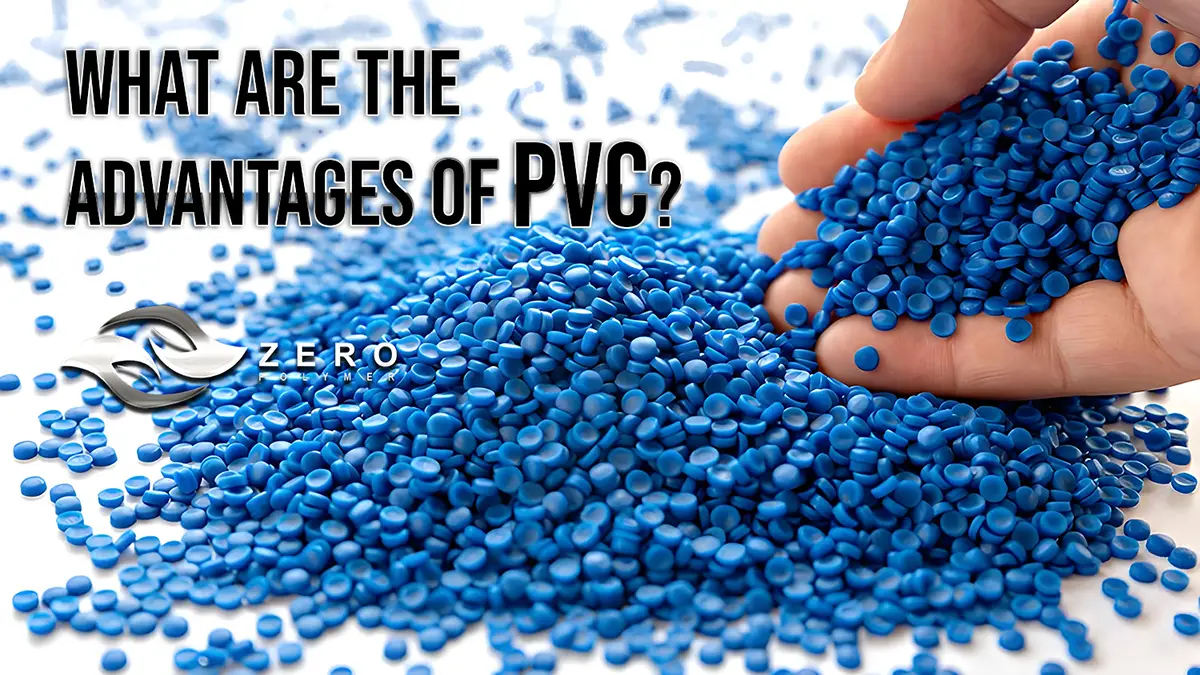
Advantages of PVC in Various Industries
PVC is a versatile, cost-effective, and durable material with numerous advantages in various industries, including construction, healthcare, electronics, packaging, and automotive. Its unique properties make it an ideal choice for a wide range of applications, contributing to its widespread use and popularity. Here is a list of the advantages it offers:
Construction
- Lightweight and durable material, making it easier to transport and install
- Good mechanical strength and abrasion resistance
- Low cost and good value for money
- Environmentally friendly, as it is recyclable and has a long lifespan
- Resistant to weathering, chemicals, and does not conduct electricity
Healthcare
- Safe and reliable material for medical devices and equipment
- Extremely versatile and cost-effective
- Highly compatible with human tissue and blood
- Easy to clean and sterilize
- Durable and long-lasting
Sport
- Durable, water-resistant, and versatile
- It is used in sports clothing, equipment, and flooring
- PVC flooring is an excellent choice for high-traffic areas due to its exceptional durability and longevity
- Resistant to stains and spills, making it easy to maintain
- Cost-effective in the long run
- Environmentally safe and renewable
Electronics
- Good insulation material with high dielectric strength
- Resistant to UV, acids, alkalis, oils, and many corrosive substances
- Flexible and high impact strength
- Self-extinguishing due to its high chlorine content
Packaging
- Lightweight, flexible, and cost-effective
- Excellent organoleptic properties, meaning it does not affect the taste or smell of the packaged food
- Transparent and can be made in various shapes and sizes
- Easy to print on and customize
- Good chemical resistance and durability
Automotive
- Flexible, lightweight, and durable material
- Resistant to weathering, chemicals, and UV
- Good mechanical strength and abrasion resistance
- Environmentally friendly, as it is recyclable and has a long lifespan
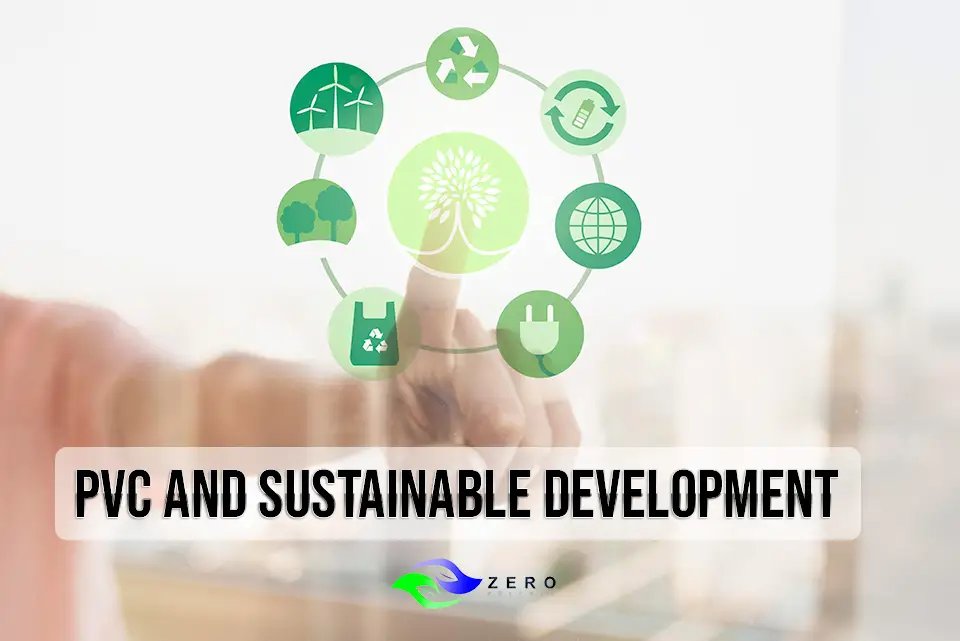
PVC and Sustainable Development
PVC is a type of plastic that doesn't biodegrade, which has caused concern about its effects on the environment and human health. It can accumulate in ecosystems and lead to microplastic ingestion by humans. Despite these concerns, PVC is important for quality, comfort, and safety in modern living. Its cost-to-performance ratio makes it accessible to people of all income levels, which supports sustainable development. PVC pipes contribute to the UN's Sustainable Development Goals by enabling more efficient food production and supporting access to clean water and sanitation.
Triad of Economic, Social, and Environmental Sustainability
Polyvinyl Chloride (PVC) is a versatile and widely used synthetic material derived from natural resources such as oil, gas, and salt. It plays a significant role in various industries and applications, contributing to the economic, social, and environmental sustainability of modern life.
Economic Sustainability
PVC's economic sustainability stems from its cost-effectiveness and durability. It is an affordable material that offers excellent value for money, making it accessible to people of all income groups. PVC's long service life reduces the need for frequent replacements, further contributing to its economic sustainability.
Social Sustainability
PVC's social sustainability is evident in its widespread use in applications that improve people's lives and conserve natural resources. Companies benefit from PVC in various sectors, including healthcare, construction, electronics, automotive, and sports. As a result, it provides safe, reliable, and durable solutions.
Environmental Sustainability
While there are concerns about PVC's environmental impact, the industry has made strides in improving its sustainability through efficient manufacturing processes and recycling initiatives. PVC has a lower carbon footprint compared to alternative materials like metal or glass. Companies can recycle and reuse it, which helps minimize waste.
Moreover, PVC's durability and long service life contribute to its environmental sustainability by reducing the need for frequent replacements and associated waste. The production of PVC is energy efficient, using less energy and fewer resources compared to some other materials.
Recycling and Life Cycle Assessment of PVC
Polyvinyl Chloride (PVC) is one of the most widely used thermoplastic polymers in the world, with applications ranging from construction to the automotive industry. However, its complex composition and the presence of toxic additives have led to misconceptions about its recyclability and environmental impact. Let’s explore the recycling methods of PVC, its life cycle assessment, and the environmental implications of its use.
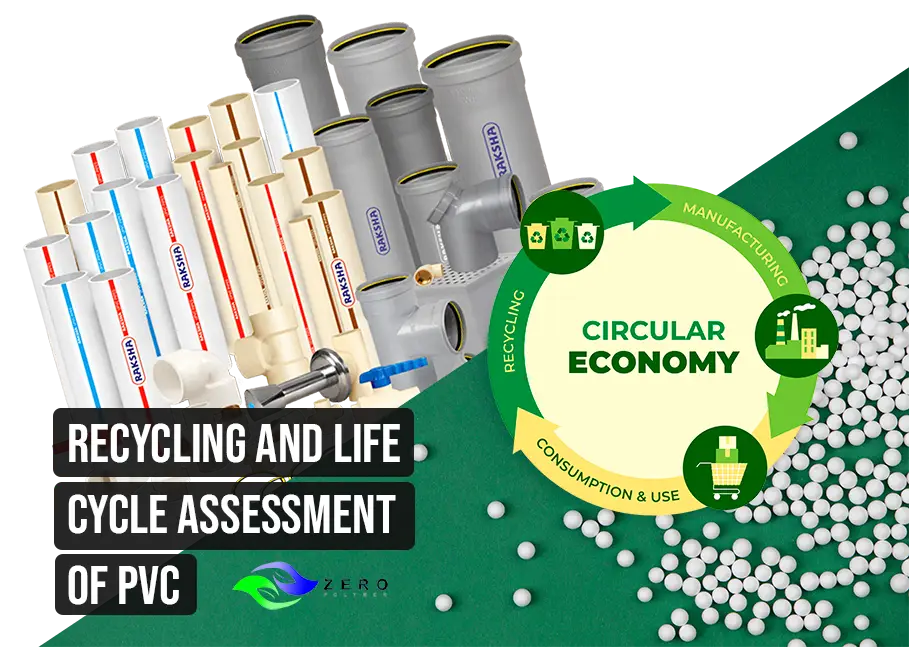
PVC Recycling Methods
There are two primary methods for recycling PVC: mechanical and chemical recycling.
Mechanical Recycling
Mechanical recycling involves grinding the PVC into small particles. After that, a producer can remelt and remold them, with or without fresh material, to create the same or different products. This method is recommended for waste that cannot be mechanically recycled.
Chemical Recycling
Chemical recycling involves processes such as pyrolysis or hydrolysis to convert the waste into other products like sodium chloride, calcium chloride, and hydrocarbon products. Companies can use these to produce new PVC or as feed for other manufacturing processes.
Life Cycle Assessment of PVC
A life cycle assessment (LCA) of PVC involves evaluating the environmental impacts associated with all the stages of a product's life from cradle to grave. This includes the extraction and processing of raw materials, manufacturing, distribution, use, repair and maintenance, and disposal or recycling.
PVC has a service life of about 100 years. It can undergo recycling up to 6 or 7 times, potentially lasting up to 600 years. However, the production of PVC is energy-intensive and involves the use of hazardous materials like chlorine, carbon, and ethylene. The production process also releases harmful chemicals and contributes significantly to CO2 emissions.
Environmental Implications of PVC Use
PVC production requires large amounts of electricity and contributes to global warming due to its high energy consumption and CO2 emissions. The production process also involves the use of toxic additives like plasticizers, lead, cadmium, and organotins, which can leach from the plastic during use, contaminating the environment. When PVC waste is incinerated or left in landfills, it can release dioxins, one of the most toxic chemicals ever produced. Therefore, recycling PVC is crucial to mitigate these environmental impacts.
Best Practices for PVC Recycling
To ensure effective PVC recycling, it's important to separate PVC waste from other types of waste. Using distinctly colored bins for different types of plastics can achieve this. Additionally, it is advisable to place recycling bins near operational points, such as pallet unloading, unwrapping, or wrapping stations.
In conclusion, while PVC has a significant environmental impact due to its production process and the use of toxic additives, it also has high recycling possibilities. Effective recycling methods and practices can significantly reduce the environmental impact of PVC.
Zero Polymer: Your Premier Choice for Reliable Supply
At Zero Polymer Trading Company, we have a long history of operating within the global trade sector and have built a reputation for offering top-notch exports to our clients. With a presence in every corner of the globe, we work closely with reliable business partners worldwide to ensure our customers receive the most favorable commercial terms possible.
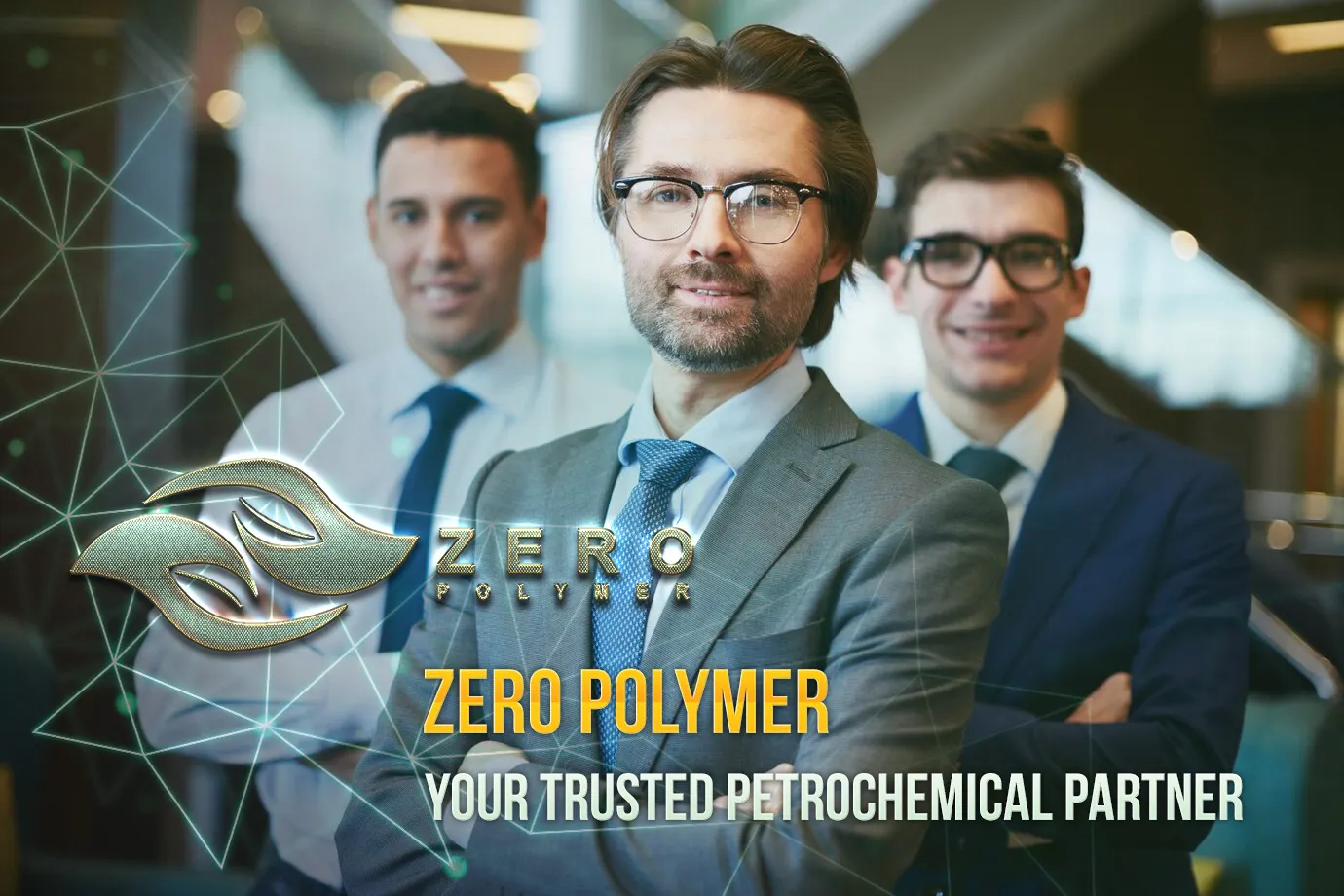
Why Choose Zero Polymer Trading Group?
- Diverse Core Activities: Offering a wide range of services, from supplying raw materials and engineering compounds to providing specialized services and technical collaboration in various industries.
- Innovative Solutions: Dedicated to delivering innovative solutions across automotive, household appliances, electrical sectors, and more.
- Global Presence: With extensive exporting and importing capabilities, we ensure seamless international transactions, providing customs clearance and transportation services worldwide.
- Proven Achievements: Our milestone of establishing direct communication with producers reflects our commitment to product improvement and being a leading producer of polymer materials.
- Environmental Commitment: Focused on environmental preservation, we lead in the production of biodegradable polymers, contributing to a waste-free world.
- Comprehensive Services: Offering a one-stop location for polymer research, testing, and manufacturing processes, we provide support, after-sales services, and training courses in commerce and exports.
- Youth Employment: Committed to sustainable development, we emphasize youth employment and make significant contributions to research and development for technological advancements.
- Mission and Values: Our social mission, effective roles in professional organizations, and influential contributions to conferences align with our values of entrepreneurship, knowledge emphasis, quality commitment, and innovation.
- End-to-End Services: From consultancy and financing to procurement, packaging, inspection, laboratory testing, and timely and reliable delivery, we ensure a comprehensive suite of services for our customers.
- Sustainable Practices: Our commitment to sustainability extends to responsible development, respect for employees, and the creation of a healthy competitive environment in business.

What Sets Us Apart
Choosing Zero Polymer means aligning with a company that not only meets your immediate needs but also shares a commitment to excellence, innovation, sustainability, and social responsibility in the polymer industry.
Our valued customers are our top priority. We strive to make the process of acquiring a wide range of chemicals and polymers as convenient as possible.
Whether you're searching for basic raw materials or sophisticated petrochemical goods, please don't hesitate to reach out to us. Our skilled staff at Zero Polymer will do their utmost to meet your requirements.
Get in Touch
At ZPolymer.com, we value your inquiries and feedback. Our team is here to assist you with any questions or requests you may have. Whether you need information about our products, pricing, or collaboration opportunities, we are dedicated to providing prompt and reliable support.
Reach out to us today and discover how we can meet your polymer needs with our exceptional solutions.
